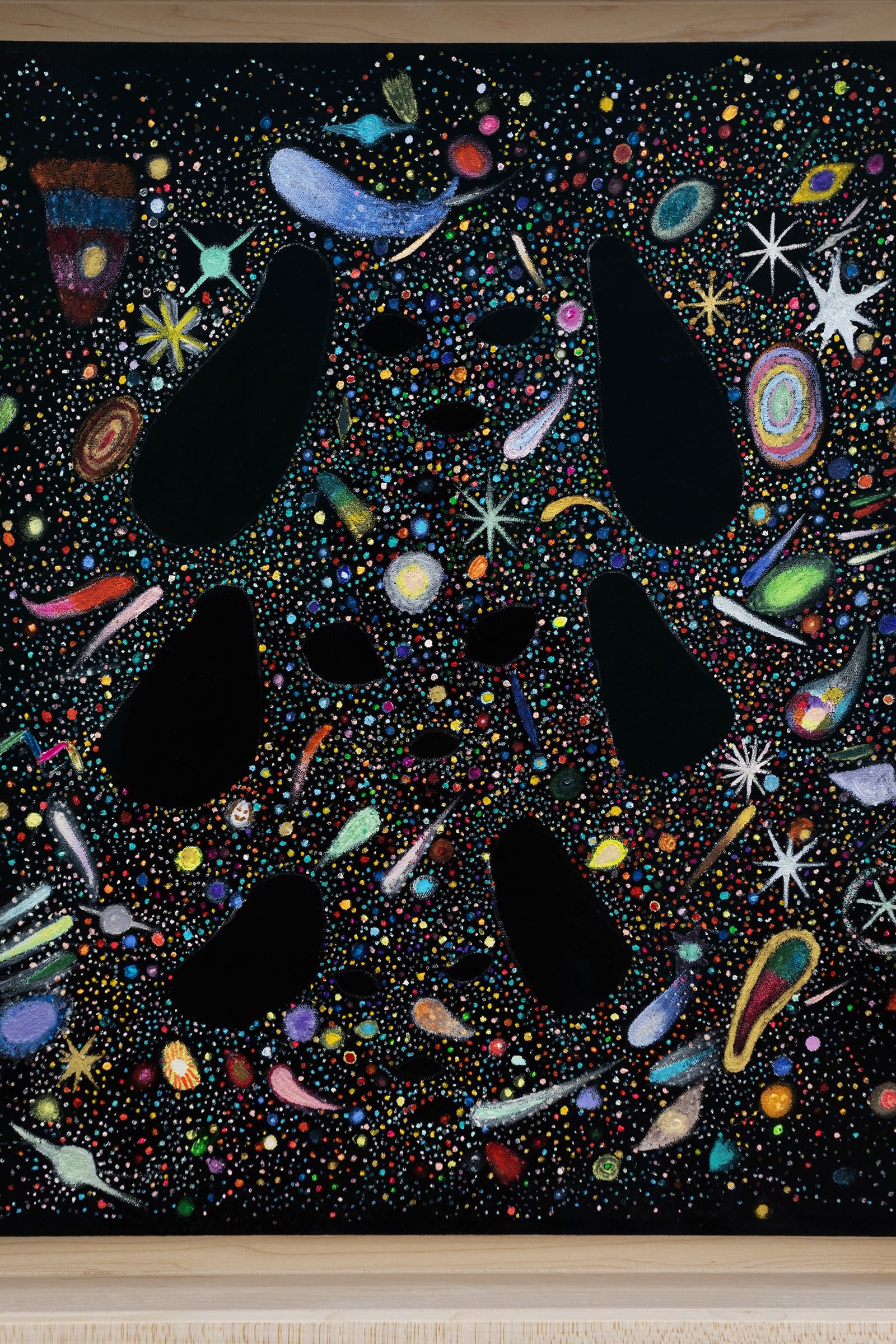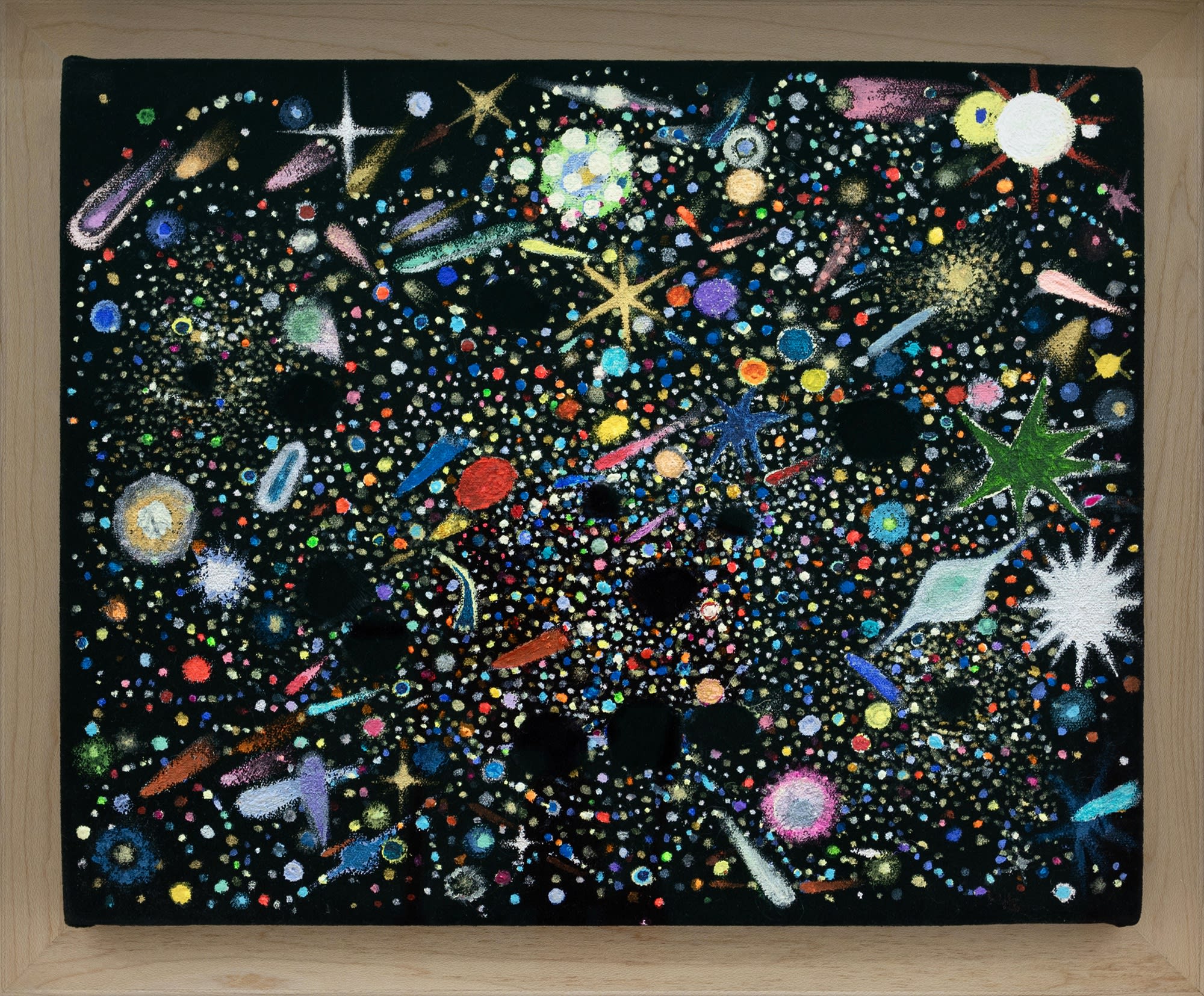 Portrait of Penny Davenport. Courtesy of the artist and OTP Copenhagen. Photo by Jason Thompson
Portrait of Penny Davenport. Courtesy of the artist and OTP Copenhagen. Photo by Jason Thompson
OTP: What is it about galaxies that first attracted your interest for this body of work?
PD: The wonder of them, the enormous distances and sizes and numbers, the inconceivable vastness. Maybe I wanted to be out of this world for a bit too – looking out rather than in.
OTP: Do these paintings have a particular interest in the relationship between the human mind and the universe?
PD: I’m interested in the mind. The mind gives life to the body.
The stars and the structure of the universe are analogous to the structure of the body, if you think about the synapses and filaments in the brain. I think our bodies are a microcosm of the wider universe as a whole. The illusion of seeing patterns and shapes in the stars is similar to the illusion of “self”. The way we put shapes into the stars and constellations speaks to the way our brains are set up to find patterns and generate meaning. It’s all projection.
The mind and the universe also resemble each other in curious ways. Human consciousness or intelligence allows the universe to recognise itself. If there’s another intelligence out there I wonder does it have the same longing to connect with us?
 Penny Davenport, Do They Still Remember, 2024, acrylic and watercolour on velvet, 55.5 x 50.5 cm / 21.9 x 19.9 inches [framed in maple with 70% UV ultra-vue glass]. Courtesy of the artist and OTP Copenhagen.
Penny Davenport, Do They Still Remember, 2024, acrylic and watercolour on velvet, 55.5 x 50.5 cm / 21.9 x 19.9 inches [framed in maple with 70% UV ultra-vue glass]. Courtesy of the artist and OTP Copenhagen.
OTP: What sort of role does yearning play in this body of work?
PD: Yearning. When you want something you could never have – the impossibility of having something that’s impossible to obtain. Even if that’s just an understanding of what you are or what you want to be. There’s a tragedy in yearning.
In the same way, you will never know fully understand another human being – the inner world – the secrets, what we lock up and never reveal so that chaos is kept at bay. The mind is a universe but we still would love to understand one fully and feel at home there.
There’s a yearning to understand everything more fully – to understand and be understood perfectly, the soul craves this and feels starved without it. It’s never enough is it? It’s difficult to be satisfied, but to be sated in pleasure and fulfilment also has its drawbacks. Perhaps the pain of yearning is exactly what we need to grow.
OTP: Could you tell me about how these paintings relate to human relationships?
PD: Human relationships are both close and distant, violent and loving and just like the philosophical ideas of “thrownness” [that humans are thrown into existence] we land in the world without any choice or say as to where we arrive.
There is no control over whom you might be raised by or encounter in a lifetime – it brings up ideas of fate, pattern and inevitability. Entropy in the universe and in our own lives allows brief pockets of order but we must eventually give in to something which cannot be determined.
 Penny Davenport, Of Our Wishes, 2024, acrylic and watercolour on velvet, 42.5 x 47.5 cm / 16.8 x 18.7 inches [framed in maple with 70% UV ultra-vue glass]. Courtesy of the artist and OTP Copenhagen.
Penny Davenport, Of Our Wishes, 2024, acrylic and watercolour on velvet, 42.5 x 47.5 cm / 16.8 x 18.7 inches [framed in maple with 70% UV ultra-vue glass]. Courtesy of the artist and OTP Copenhagen.
OTP: How do you approach the infinite in this body of work? Is there something terrifying or reassuring about this endlessness?
PD: Ideas of infinity give rise to infinite possibilities which allow the imagination to really play. And in this sense it’s a source of comfort. The only terrifying thing about infinity is the inability to conceive it. There’s a limit to what we can understand… it’s humbling isn’t it? To recognise the smallness of our lives, the beauty, the pointlessness. The fact that it will die and so will we. Eventually it will all be embers.
OTP: Would you describe these works as escapist?
PD: When I was making them I wanted to escape my own thoughts and problems. Maybe I wanted to look up to something very great and indifferent.
 Penny Davenport's Studio. Courtesy of the artist and OTP Copenhagen.
Penny Davenport's Studio. Courtesy of the artist and OTP Copenhagen.
OTP: What sort of source materials inform your conception of distant galaxies? Do you look at NASA images a lot? Have you seen many documentaries or films about space?
PD: I do look at NASA images. I have watched Carl Sagan. I watch films set in space, you know, the usual ones. I wouldn’t say I’m a massive fan of space movies or anything like that though, but I do love images or ideas of space because I just can’t grasp it all and it makes me feel both anxious and excited.
I do look at NASA images, you can’t argue with the beauty of them but I also love medieval depictions of stars and comets and heavenly wonders and these ancient attempts to interpret the sky and beyond.
OTP: There is an abstract pointillism that seems to emerge in these works - what role does repetition play when it comes to the mark-making here?
PD: Making these paintings was a kind of maddening process because there were dots over dots over dots so that under some of these dots there are many different colours and there’s a kind of prehistory that has evolved into a final image. We can’t see the history – we can only see the end point. That’s not too dissimilar to a person – you never see the full history of a person, their experiences, what has formed them, only how they appear to us now.
 Penny Davenport, Falling Everywhere, 2024, acrylic and watercolour on velvet, 32.5 x 37.5 cm / 12.8 x 14.8 inches [framed in maple with 70% UV ultra-vue glass]. Courtesy of the artist and OTP Copenhagen.
Penny Davenport, Falling Everywhere, 2024, acrylic and watercolour on velvet, 32.5 x 37.5 cm / 12.8 x 14.8 inches [framed in maple with 70% UV ultra-vue glass]. Courtesy of the artist and OTP Copenhagen.
OTP: Do you see a relationship between these works and Yayoi Kusama’s ‘Infinity Nets’? Were there particular artists you have been thinking about whilst making this body of work?
PD: I can see how a relationship or connection to Kusama’s Infinity Nets could be drawn, as there are similar themes being dealt with. I have seen the work, and there is a joyful inclusiveness about this work that is not too dissimilar to the NASA images. They are difficult to react negatively to because the work is hard to argue with in that it’s dealing with an endlessly fascinating idea.
There are no specific artists I’ve been thinking about whilst making this work although I’m not denying influences. I can't work very well if I can’t play and I can’t play if I’m too keenly aware of others.
OTP: The human animal figures which have been a hallmark of your work in the past are present in this exhibition, but in a more subtle way. Could you tell me about why you choose to approach figuration in this way?
PD: Because I think the work is about a kind of oceanic merging, maybe the smallness of us is negated by projecting an agency into the vastness of patterns of galaxies. Sometimes it isn’t until later that I understand that I’ve had any kind of clear approach. It’s only on reflection that I can have an impression of why what has occurred in the paintings has occurred, perhaps in the same way it takes time to see light from a distant supernova.
OTP: If you have been drawn to a more abstract mode of working, why do you think that is?
PD: If I have been, it has been to some extent unconsciously done. Stars and galaxies are, in one sense, just abstract patterns of light. In abstraction there is room to explore other ways of seeing and feeling and expressing things. Sometimes I want to feel the excitement that novelty can bring and perhaps the lack of safety in it.
 Penny Davenport, Galaxy Paintings, 2024, installation view. Courtesy of the artist and OTP Copenhagen.
Penny Davenport, Galaxy Paintings, 2024, installation view. Courtesy of the artist and OTP Copenhagen.
Penny Davenport (b. 1979, Inverness; UK) lives and works in Liverpool, United Kingdom. The artist holds a BFA from John Moores University (Liverpool; UK).
Recent exhibitions include: The Passing of Time at Nidi Gallery (Tokyo; JP); The Look of a Look That's Looking at Harkawik Gallery (New York City, NY; US); Andante Remix at Linseed Projects (Shanghai; CN); Postcards at Galleri Magnus Karlsson (Stockholm; SE).
